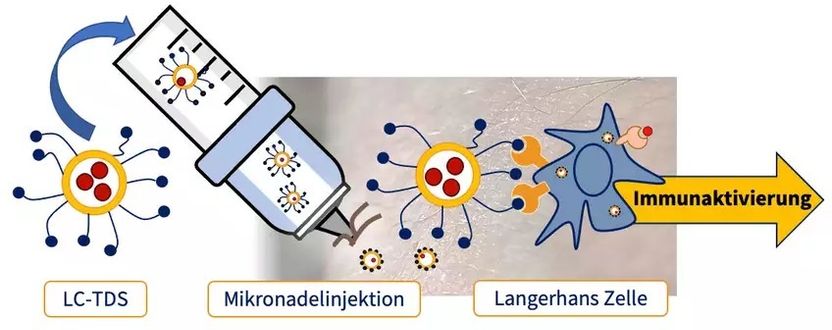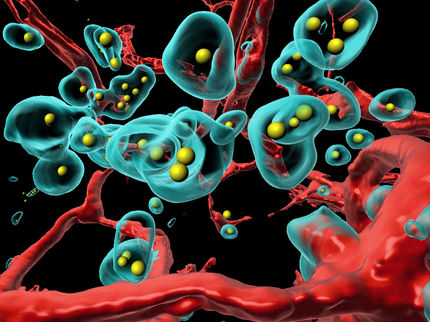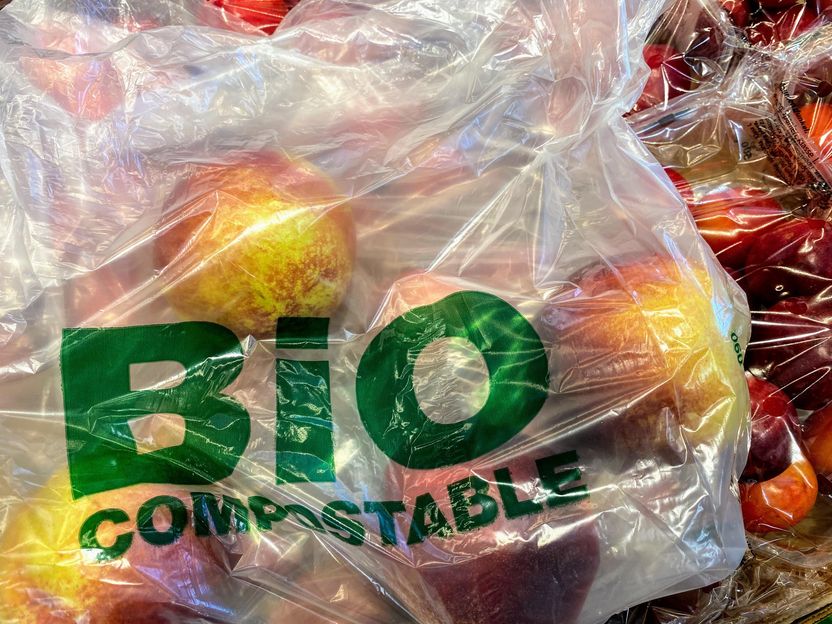Targeted immune stimulation for more effective vaccines
Cutanos, a spin-off from the Max Planck Society, is developing novel vaccines and immunotherapies
In the future, it could be possible to stimulate the immune system with extremely high efficacy via the skin. Cutanos GmbH, a spin-off from the Max Planck Institute of Colloids and Interfaces, has developed a corresponding method for modulating immune cells in the skin. The LC-TDS technology makes it possible to specifically influence certain cells of the immune system and thus fight various infections and diseases. Founded in Vienna in January, the start-up has concluded an exclusive licence with the Max Planck Society for this novel procedure and is now developing innovative immunotherapies based upon it.

Working principle of the Langerhans Cell Targeted Delivery System (LC-TDS).
© Cutanos GmbH
Bacteria and viruses are recognised by various cells of the immune system via antigens, i.e. external molecular structures that are specific to each pathogen. Antigens are therefore a popular basis for vaccines and immunotherapies designed to train the immune system to fight pathogens. However, these antigens are detected by a multitude of different receptors on different immune cells, which can sometimes result in divergent reactions within the immune system. Now, for the first time, a new method developed at the Max Planck Institute of Colloids and Interfaces in Potsdam is making it possible to supply only a specific type of immune cell with antigens in order to trigger a controlled immune response. Known as "Langerhans cells", these cells are predominantly located in the uppermost skin layer (epidermis) and contain the Langerin receptor, which is specific to them. The technique developed at the Max Planck Institute allows exclusive access to these immune cells via an artificially produced ligand that only binds to Langerin.
LC-TDS technology elicits the desired immune response
The Langerin-specific ligand is the core of the Langerhans Cell Targeted Delivery System, (LC-TDS). In addition to the ligand, this modular system includes a transport system (vehicle) and the active substances or antigens to be delivered (cargo). The ligand is a small, synthetically produced molecule that sits on the surface of the carrier in large numbers. Due to its high binding specificity for Langerin, it ensures that the vehicle is detected and processed by the Langerhans cells just like a natural pathogen. Liposomes, proteins, LNPs (lipid nanoparticles) or other microparticles serve as the vehicles. Studies on epidermal cell suspensions as well as human skin explants have shown that the LC-TDS is taken up by 97 per cent of Langerhans cells, whereas only 0.1 percent of other, so-called off-target cells are addressed. This combination of high specificity and selectivity allows the active substances to be transported and with extreme precision. The cargo can be small molecules, peptides, proteins or mRNA. Since the addressed Langerhans cells are located in the top layer of the skin, LC-TDS can be administered via minimally invasive microneedles.
As mediators of immunity and tolerance, Langerhans cells are able to distinguish between foreign and endogenous antigens. Therefore, the LC-TDS can be applied in different areas for the purpose of immune activation and regulation. As a result, Cutanos is currently working on antiviral vaccines and therapies for autoimmune diseases. In addition, drug delivery can also be used to specifically kill cancerous Langerhans cells, as is necessary in cases of Langerhans cell histiocytosis, for example.
Funding secures development
Cutanos GmbH has set itself the goal of developing the LC-TDS to market maturity and marketing it internationally. For this purpose, it has rented office and laboratory space on the campus of the University of Vienna, where it has access to the institution's research infrastructure. The two founders, Christoph Rademacher and Robert Wawrzinek together with other scientists, conceived the novel method at the Max Planck Institute of Colloids and Interfaces in the department of Peter H. Seeberger, and have now exclusively licensed it as part of their spin-off, which was founded in January. In addition, the start-up has successfully secured funds from an international consortium of investors as part of its current seed-funding round. "The successful spin-off of Cutanos is a perfect example of how breakthroughs in basic research can be implemented so that important medical challenges can be addressed," says Peter H. Seeberger, Director of the Biomolecular Systems Department at the Max Planck Institute.
Cutanos GmbH's business model envisages adapting the technology to the individual needs of its customers in the biotech and pharmaceutical sectors in the future. Thus, the company will present the design, formulation and preclinical in vitro and in vivo experiments with the goal of creating customised LC-TDS solutions. In addition, following successful proof of concepts (PoCs), Cutanos will advance the application of its method into clinical development for the indications of antiviral vaccines, Graves' disease and Langerhans cell histiocytosis.
Max Planck Innovation, the technology transfer organisation of the Max Planck Society, has long supported and accompanied the startup's establishment – and has now licensed the LC-TDS technology to the fledgling business. "We are very enthusiastic about the LC-TDS approach being developed by Cutanos. The scientists' tireless efforts, together with the SARS-CoV2 project funded by the KHAN Technology Transfer Fund I (KHAN-I), has finally helped to get the new company off the ground and laid the foundation for the current funding round," says Mareike Göritz, Senior Patent and Licensing Manager at Max Planck Innovation. "We are pleased that the two co-inventors Christoph Rademacher and Robert Wawrzinek continue to contribute their great expertise in this field to bring the technology to the market and thus to the patients."
Other news from the department business & finance
Most read news
More news from our other portals
Something is happening in the life science industry ...
This is what true pioneering spirit looks like: Plenty of innovative start-ups are bringing fresh ideas, lifeblood and entrepreneurial spirit to change tomorrow's world for the better. Immerse yourself in the world of these young companies and take the opportunity to get in touch with the founders.
























































